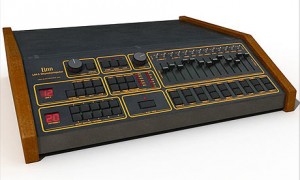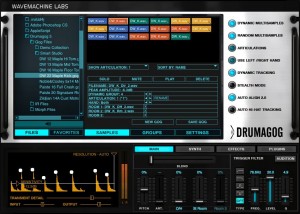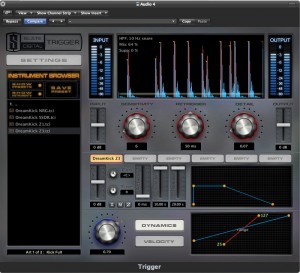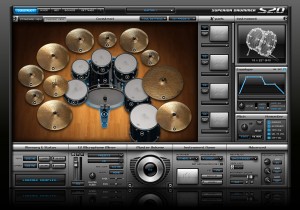The Next Generation of Drum Replacers
Drum replacement – or at least drum augmentation – has been part of recorded music since as early as the 1960s, when Phil Spector took to layering live percussion instruments to help create his “Wall of Sound.” It’s a basic technique that only become more prevalent and sophisticated as specialized tools become cheaper, faster and easier to use.
In 1979, drum replacement and augmentation took a giant leap forward with two inventions: Roger Nichols’ “Wendel” drum sampler, first used on Steely Dan’s Gaucho, and Roger Linn’s LM-1 Drum Computer, made famous by Prince, Michael Jackson and Gary Numan.
The 12-bit digital technology in these devices allowed something that was never really possible with early synthesis-based analog drum machines: the ability to trigger actual recorded samples of authentic drum hits, which could then be used alone or layered underneath a performance.
With the advent of MIDI control in the early 1980s and DAWs in the 1990s, drum replacement and augmentation became increasingly practical in genres of music that rely on live performance.
From Def Leppard’s schlocky Hysteria to Nirvana’s culture-shifting Nevermind, drum triggers have worked their way deep into our industry to become an indelible part of the sound of recorded music, and their affects can be heard in the biggest hits by Metallica and The Smiths alike.
Although many styles of music may still benefit from an unhyped and au naturel approach, drum replacement or augmentation has become a cornerstone of entire genres of modern rock, metal and pop – not to mention dance and electronic music. If you work on those kinds of projects from time to time, a reliable method for tracking and triggering hits is a must.
Whether the goal is a natural sound with a little extra impact and texture, or a synthetic and over-the-top concoction, good drum replacement software needs to be three things: Accurate, flexible and fast – in that order.
Massey DRT v2.0 ($99)
One of the newest additions to the current crop of drum replacers is version 2.0 of Massey’s Drum Replacement Tool. It may be one of the simplest and most effective tools of its type.
Visually and in use, DRT owes much of its heritage to the first major DAW-based drum replacement tool: Avid’s now-venerable Sound Replacer, which sells for a street price of $395.
Like Sound Replacer, Massey’s DRT is an AudioSuite-only plugin for Pro Tools. But unlike Sound Replacer, DRT gives professional-level performance for a price that’s a no-brainer even for hobbyists.
At $99, DRT is a “just buy it already” kind of purchase for any Pro Tools user in need of an affordable, high-performance drum triggering program.
DRT gets high marks in the “Accuracy” category, and many Massey fans even prefer this plugin to Avid’s far more expensive Sound Replacer. Thanks to a smart algorithm and powerfully simple controls, I was able to get DRT to spit out sample-accurate and dynamic results with minimal fuss and no misfires.
As far as “Flexibility” goes, this plugin is only as good as your own sample library is. With DRT, you can generate MIDI note data from live drum performances and then feed it into a 3rd party drum sampler. Alternately, you can load the plugin with audio samples of your own, and DRT even allows you to create and save custom velocity-sensitive libraries on the fly. But if you’re looking for built-in samples and sounds, you won’t find them. Note that DRT is 100% BYO.
In the “Fast” department, Massey’s Drum Replacement Tool is easy to set and provides sample-accurate trigger points in the blink of an eye. With that said, speed may be one place where other types of replacers can have a leg up. Unlike the AudioSuite-only DRT, real-time drum replacers that include built-in libraries will allow users to quickly toggle between trigger settings and drum patches without stopping to process. This is one function that’s just not possible within the Massey plugin.
Although DRT integrates seamlessly with 3rd party drum machines and samplers, if you don’t already have one that you like to use, you may find that loading your own samples into the interface and saving new sound banks will take a little bit of time as you first get started. But for those who take an individualist or DIY approach to drum sampling, DRT may be the perfect tool.
WaveMachine Labs Drumagog 5 Basic ($89) Pro ($269) & Platinum ($359)
WaveMachine Labs has been a major player in the replacement field since 1999. Unlike the minimalist Massey DRT, their Drumagog plugin comes with its own library of sounds which can be auditioned in real-time. This makes hearing and switching between samples in-context a breeze.
I was a Drumagog user as early as version 3, and although I was fan of the program, I found that the real-time functionality, which was so attractive in principle, required plenty of patience in reality.
Back then, it took some finessing to avoid misfires. And, even once you had that settled, your best bet was to print the plugin’s output to a separate track, and then comb through the hits to consistently phase-align your samples by hand.
Enter Drumagog Version 5, and it appears that these early pioneers of plugin replacement have caught up and continued to innovate. We have yet to write our own review, but fans of the program say it has its most seamless triggering yet, and provides better sample alignment than ever before.
WaveMachine Labs has also continued to trailblaze with unique new features that can’t be found elsewhere: Sweepable EQ filters allow isolation of a single drum from tracks rich with bleed, and the plugin even has the ability to distinguish between open, half-open and closed hi-hats.
In addition to a stock sample library and the option of custom refill packs, the basic versions of Drumagog also include a built-in convolution reverb and an analog-style drum synthesizer.
It’s likely that similar plugins will integrate many of Drumagog’s unique features soon, but it’s nice to know that WaveMachine isn’t just playing catchup, and can still beat other developers to the chase.
Drumagog is available via both RTAS and AU, and VST users even have the option to open other VST plugins within Drumagog itself, removing the need to even bother with DAW-based MIDI routing.
Steven Slate Drums EX ($99) & Platinum ($249) and Steven Slate Trigger EX ($99) & Platinum ($249)
The success of Drumagog in the 2000s spawned a whole genre of one-stop drum replacement and augmentation programs.
Audio developer Steven Slate first made a name for himself by issuing popular 3rd party sound libraries for Drumagog, and since then, his company has released a drum trigger of its own, which sells for $249, or $99 as a light version.
At the time it was released, fans of the Slate Trigger found it was well worth the price, and served as a welcome improvement over Drumagog 4 in both accuracy and speed.
Now that Drumagog 5 is out, this gap seems to have closed considerably. Still, there’s another factor that remains a unique selling point for Slate: It’s the sound of Slate Drums that have been most significant in helping the company carve out a niche.
But depending on who you ask, that sound can also be a liability. These popular sample packages may be as polarizing as they are processed.
On the whole, Slate’s samples can be as upfront, brash and bombastic as the company’s image. For dedicated users, these mix-ready sounds are part of the allure. They’re drum samples ripped from modern hit records like a Law & Order episode is ripped from the headlines, and come pre-polished to a slick, radio-ready sheen.
For conservative styles of modern radio-rock and pop in which certain sonics are expected and assumed “normal”, these samples may often offer the perfect fit with minimal fuss. But to producers, mixers and artists who prefer to sculpt their own sounds, Slate’s preprocessed libraries can sometimes feel limiting.
There’s no question that Slate Drums and Slate Trigger are useful, cost effective and powerful tools. But whether or not they’re flexible? That seems to be in the ear of the beholder.
Toontrack EZDrummer ($79) and Superior Drummer 2.0 ($299)
Our own Zach McNees wrote a glowing review of Toontracks Superior Drummer last September. When I finally dropped by his place for an extended tour of the program, I could hear why he was so impressed.
Originally designed as a definitive sound library for virtual drummers, composers and producers, these Toontrack plugins aren’t drum replacers per se, as they lack built-in triggers of their own.
Although Toontrack does make its own standalone trigger called Drum Tracker, where its line of plugins really excel is in interpreting MIDI trigger data with nuance and grace, and in providing startlingly realistic samples that may prove nearly impossible to top.
For each of Toontrack’s soundbanks, a fantastic, well-known engineer records a fantastic, well-known player at a fantastic, well-known studio. Even the default pack was tracked at world-famous Avatar studios by Grammy-winning producer Neil Dorfsman, and it’s among the best default libraries out there. The sounds are certainly mix-ready, but they’re not so preprocessed as to paint a mixer into a corner.
There’s a welcome degree of overkill that goes into each of these sound banks – and the scope of the interface. Each and every sample is multitracked at a wide range of velocities, and even if your mission is to simply augment a snare drum, you have the ability to blend in close mics, overheads, multiple room mics, and even bleed into the other kit mics as much or as little as you like using a built-in mixer.
In addition, Toontrack sample packs often let you change between stick types: regular, brushes, malletts – or strike point: center, rim, even the bell or edge of cymbal. The velocity mapping on Superior Drummer is mind-blowing as well, and even using a mouse, McNees was able demonstrate a convincing dynamic range unsurpassed by any other programs I auditioned.
Slate and Drumagog have similar features, but maybe not to the unprecedented (and perhaps over-designed) degree of Toontrack’s Superior Drummer. As far as built-in libraries go, it offers some of the most flexible and inspiring I’ve ever encountered. However, when it comes to actual triggering, the program is a no-go. An accurate 3rd party plugin like Massey’s DRT is still required for the time-being.
Please note: When you buy products through links on this page, we may earn an affiliate commission.












Jeekem
August 2, 2012 at 4:06 am (13 years ago)Toontrack’s Superior Drummer 2.30 IS my go to drummer. It is simply to throw together a workable drum track (or set of tracks) in a matter of minutes when you’re getting an idea down. When you’re ready to mix down there is really no limit to the customizing you can do. With the X-Drum feature you can add the exact make and model of a snare or kick or whatever choosing what is beating it and the articulation you want. You can also set up midi “nodes” to layer and tweak things even further.
Jeekem
August 2, 2012 at 4:08 am (13 years ago)Make that simple to instead of simply to